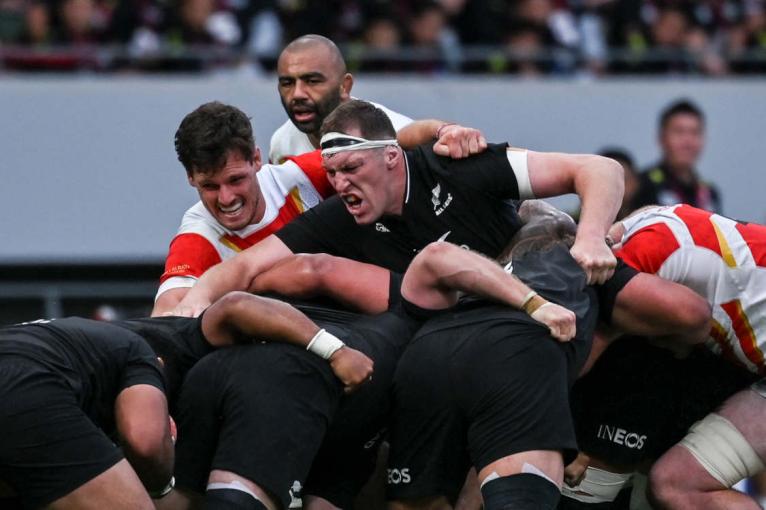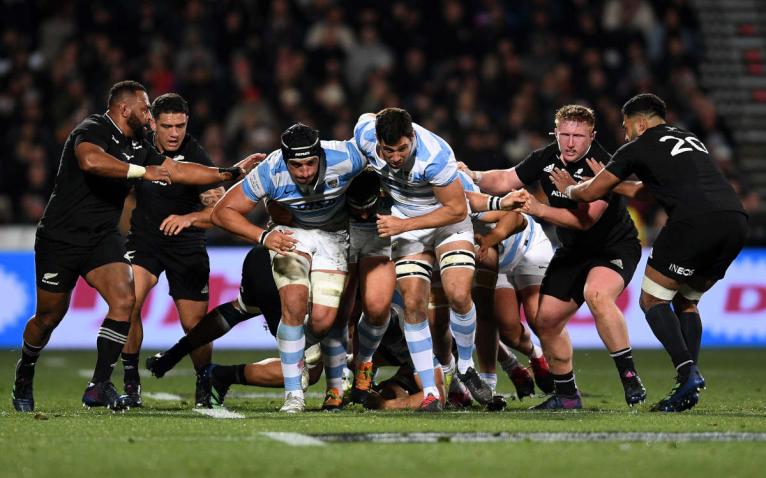The driving maul has a peculiar history in New Zealand. It’s never been a loved part of the game and for the first two decades of this century, it was seen by Kiwis as the chosen tool of teams that had no natural attacking flair or creativity and so New Zealanders had a sneering, disdain for those who relied upon it.
It was common for fans in New Zealand to mock the Northern Hemisphere sides for their love of kicking for lineouts and then putting the ball up their jumper and waddling it over the try-line.
In New Zealand, this style of rugby would never fly – the game for the last 20 years, or so, has been all about speed of movement, attacking wider channels and using the natural athleticism and skill-sets of the players to create space.
Perhaps New Zealand’s Super Rugby teams and the All Blacks felt the driving maul was beneath them, or they just didn’t think it was a worthwhile skill to develop between 2000 and 2018, but whatever the reason, it was barely seen in Aotearoa throughout that period.
After Argentina scored two tries from lineout drives against the All Blacks in the 2015 Rugby Championship, All Blacks coach Steve Hansen, said mauls were “bloody boring”.
“I want to be clear too, I’m not having a go at the ref [Craig Joubert] or the way he reffed it. I’m having a go at the laws,” Hansen said last. “He’s reffing it as the laws say you can. It’s bloody boring, though.

“You’re not allowed to have a back move where someone runs along the front of everybody and doesn’t let them tackle somebody, so have the same principles in a lineout.”
The All Blacks won that tournament in 2015 and if they did drive any lineouts, no one can remember them and throughout 2016, 2017 and the first half of 2018 New Zealand didn’t build any kind of attacking system around their driving lineout maul.
And then something changed ahead of the 2019 World Cup. The All Blacks suddenly decided they needed to be able to produce an effective driving maul if they were going to succeed in Japan.
By October 2018, the All Blacks were semi-regularly using the driving maul as their go-to option. They made a stunning comeback in Pretoria against the Boks, scoring two tries in six minutes to pull off a late, great escape.
As a sign of how dominant the maul has become, Wayne Smith, who remains one of the most respected figures in the global game, said midway through this year’s tournament that he was finding rugby almost “unwatchable”
Both those late tries were effectively built on kicking penalties into the corner and then driving from the lineout.
When they played the Wallabies in Yokohama, they mixed things up entirely, spending the first 60 minutes scrumming for penalties, kicking penalties to touch and then driving the lineout.
And most notably, that’s exactly what they did at Twickenham a couple of weeks later, somehow managing to beat England in a dogged, set-piece war of attrition where both teams endlessly used the driving maul. It was a Beauden Barrett dropped-goal that won the test for the All Blacks.
The incredible thing is, that despite saying they have no love of the driving maul, it has become a staple of the New Zealand game.
Super Rugby Pacific saw the maul become a dominant feature of many games, and last year there was a stage when there were four hookers among the leading try-scorers.
As a sign of how dominant the maul has become, former All Blacks and Black Ferns coach, Wayne Smith, who remains one of the most respected figures in the global game, said midway through this year’s tournament that he was finding rugby almost “unwatchable”.

He admitted to being frustrated with the product and that he actually gave up watching the Force play the Highlanders such was his lack of interest by half-time.
His gripe is that he feels too many games get locked into a pattern where teams win a penalty, kick for touch, drive the lineout, win a penalty, repeat.
“Every single play, there’s an advantage,” Smith told the All Blacks podcast. “Then, you know, we’re going to go seven, eight phases and if it goes nowhere, we’re going to come back and it’s going to be a penalty.
“Then, 30 seconds to kick the ball and another 40 seconds for the lineout to happen. It’s going to be a drive that’s going to collapse, and it’s going to be an arm coming out.”
Smith certainly has a point. Few would disagree that he’s right and that the cycle of penalty, maul, penalty, maul provides little entertainment value and so too is it hard to understand why referees allow teams to got through as many 10 phases and make 40 metres sometimes and yet remain under advantage.
“Nah, bloody lineout maul is great. It’s a good challenge to lay down a yardstick for your forward pack. Smithy is a good man, and he’s got a lot of interesting views and everything, but I just can’t say I’d align on this one with him.
Joe Moody
But the maul is also an integral part of the game. It’s one of the features that makes the sport what it is and it also a facet of play loved by the forwards.
As veteran Crusaders and All Blacks prop Joe Moody said when he learned of Smith’s comments: “What a ridiculous [thing to] say.
“Nah, bloody lineout maul is great. A great part of the game. It’s a good challenge to lay down a yardstick for your forward pack.
“Smithy is a good man, and he’s got a lot of interesting views and everything, but I just can’t say I’d align on this one with him.
“I’d hate to see that get thrown out or reduced in some form. You’ve got to keep it in there.”

And so we have a fascinating problem for rugby’s decision-makers to solve. The maul is an integral component in giving rugby its unique culture of physicality and enabling all sorts of body shapes and sizes to be included.
But it also sits uncomfortably within the general principles of the game – that the defending team will have a fair chance to win the ball back and that quirk of being able to put players in front of the ball has encouraged too many teams to use the maul as a default tactic.
Most fans, even Kiwis now, can appreciate the skill, discipline and organisation required to build an effective maul. And, given how hard it is to stop a maul legally, everyone can understand why teams use it as often as they do.
But, as Smith has suggested, when it starts to feel that game after game is dominated by driving mauls and that one team has gained enough ascendancy as to be able to continually extract penalties from them and move into a kick, lineout, drive, penalty, repeat cycle, then there is a danger of fans walking away from the game.
Something needs to be done to keep the maul a valid part of the game, but to discourage teams from overusing it.
“There’s never been anybody injured in a collapsed maul yet, but there’s thousands every week that get penalised. Just make that legal then it becomes half-pie a fair contest.”
Steven Hansen
If Smith were able, he’d change the law to give the opposition the throw in at the lineout if a team kicks for touch. He reckons that would be enough to discourage teams from endlessly booting into the corner.
It might, but it would also seem unfair that a team that wins a defensive penalty from a well-executed turnover on their goal-line, is then unable to throw to the lineout if they kick the ball out.
Hansen, back in 2015, perhaps offered the better solution when he suggested making the illegal, legal. “The easiest way would be to say you can collapse it,” said Hansen, when he was asked for a solution to the problem.
“There’s never been anybody injured in a collapsed maul yet, but there’s thousands every week that get penalised. Just make that legal then it becomes half-pie a fair contest.”
That would seem to be the smarter, solution required to wean New Zealanders off the very thing they used to mock the rest of the world for using.”

Although, interestingly, the knockout rounds of Super Rugby Pacific suggested there might be a more effective way still of discouraging teams from endlessly trying to drive mauls – and that is get better at legally defending the ploy.
The maul was not a feature of any of the quarter-finals – certainly not the way it had been earlier in the competition.
The driving maul has become part and parcel of the game in New Zealand and come the World Cup, the All Blacks may use it significantly more than they have during the Rugby Championship
Really, the only team that used the maul to any great effect was the Crusaders. They didn’t overdo it by any means in the final, but they were clever in the way they used it sparingly to put pressure on the Chiefs to extract penalties and yellow cards.
And, as the All Blacks showed in Mendoza, if nothing else, it can be an option just to inject variety and keep the opposition guessing what might be coming next.
The driving maul has become part and parcel of the game in New Zealand and come the World Cup, the All Blacks may use it significantly more than they have during the Rugby Championship.


What is this awful gripe? NZ are one of the best mauling sides in the world behind the Irish and Saffas. While rolling mauls are awful and should be called as shepherding, normal mauls are absolutely fine and give a great opportunity for fwds to establish dominance in a game. Rolling mauls however are absolutely atrocious and should be penalized for shielding players and preventing the tackler from playing the ball carrier.